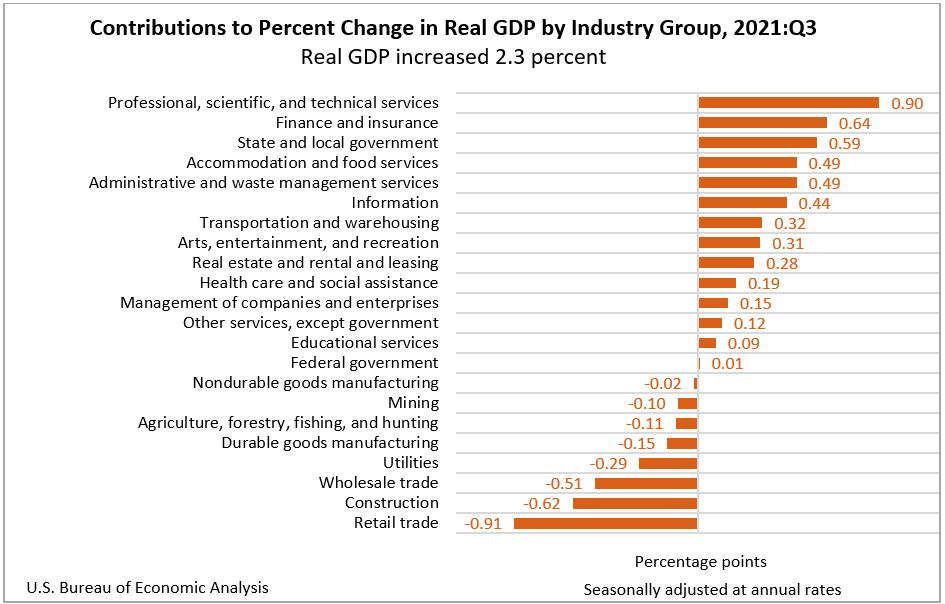Real gross domestic product (GDP) increased at an annual rate of 2.3 percent in the third quarter of 2021, following an increase of 6.7 percent in the second quarter. The increase was revised up 0.2 percentage point from the “second” estimate released in November. The deceleration in real GDP in the third quarter was led by a slowdown in consumer spending. A resurgence of COVID-19 cases resulted in new restrictions and delays in the reopening of establishments in some parts of the country. In the third quarter, government assistance payments in the form of forgivable loans to businesses, grants to state and local governments, and social benefits to households all decreased. For more details, including source data, refer to the Technical Note and Federal Recovery Programs and BEA Statistics.
GDP highlights
The third quarter increase in real GDP reflected increases in inventory investment, consumer spending, state and local government spending, and business investment that were partly offset by decreases in exports, housing investment, and federal government spending. Imports, which are a subtraction in the calculation of GDP, increased.
- The increase in inventory investment primarily reflected increases in wholesale trade (led by nondurable goods industries) and retail trade (led by motor vehicle and parts dealers).
- The increase in consumer spending reflected an increase in services, led by “other” services (mostly international travel), transportation services, and food services and accommodations. Consumer spending for goods decreased (led by motor vehicles and parts).
- The increase in state and local government spending primarily reflected an increase in compensation of state and local government employees (notably, education).
- The decrease in exports reflected decreases in both goods (led by foods, feeds, and beverages) and services (led by charges for the use of intellectual property). The increase in imports reflected an increase in services, primarily foreign travel by U.S. residents.
- The decrease in housing investment primarily reflected declines in improvements and new single family structures.
- The decrease in federal government spending primarily reflected a decrease in nondefense spending on intermediate goods and services. In the third quarter, nondefense services decreased after the processing and administration of Paycheck Protection Program loan applications by banks on behalf of the federal government ended in the second quarter.
Updates to GDP
The update primarily reflects upward revisions to consumer spending and inventory investment that were partly offset by a downward revision to exports. Imports, a subtraction in the calculation of GDP, were revised down.
Personal income and saving
Real disposable personal income — personal income adjusted for taxes and inflation—decreased 4.3 percent in the third quarter after decreasing 29.1 percent in the second quarter.
Current-dollar DPI increased primarily reflecting an increase in compensation of employees. The increase was partly offset by a decrease in government social benefits related to pandemic relief programs, notably unemployment insurance. Personal saving as a percentage of DPI was 9.5 percent in the third quarter, compared with 10.9 percent in the second quarter.
Corporate profits from current production
Profits increased 3.4 percent at a quarterly rate in the third quarter after increasing 10.5 percent in the second quarter.
- Profits of domestic nonfinancial corporations increased 1.7 percent after increasing 13.8 percent.
- Profits of domestic financial corporations increased 2.6 percent after increasing 10.9 percent.
- Profits from the rest of the world increased 11.1 percent after decreasing 1.3 percent.
Corporate profits increased 19.7 percent in the third quarter from one year ago.
Gross domestic product by industry
Today’s release includes estimates of GDP by industry, or value added—a measure of an industry’s contribution to GDP. Private goods-producing industries decreased 5.5 percent, private services-producing industries increased 3.9 percent, and government increased5.1 percent. Overall, 14 of 22 industry groups contributed to the third-quarter increase in real GDP.
- The decrease in private goods-producing industries was widespread, led by construction.
- The increase in private services-producing industries primarily reflected increases in professional, scientific, and technical services; finance and insurance (led by securities, commodity contracts, and investments); accommodation and food services; administrative and waste management services (led by administrative and support services); and information (led by motion picture and sound recording industries).
- The increase in government primarily reflected an increase in state and local government.
For more information, read the full release.
